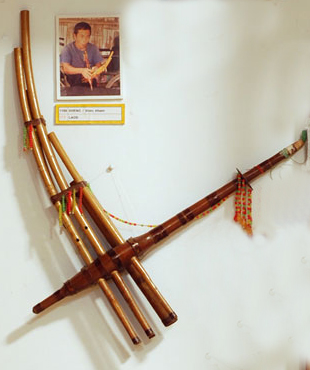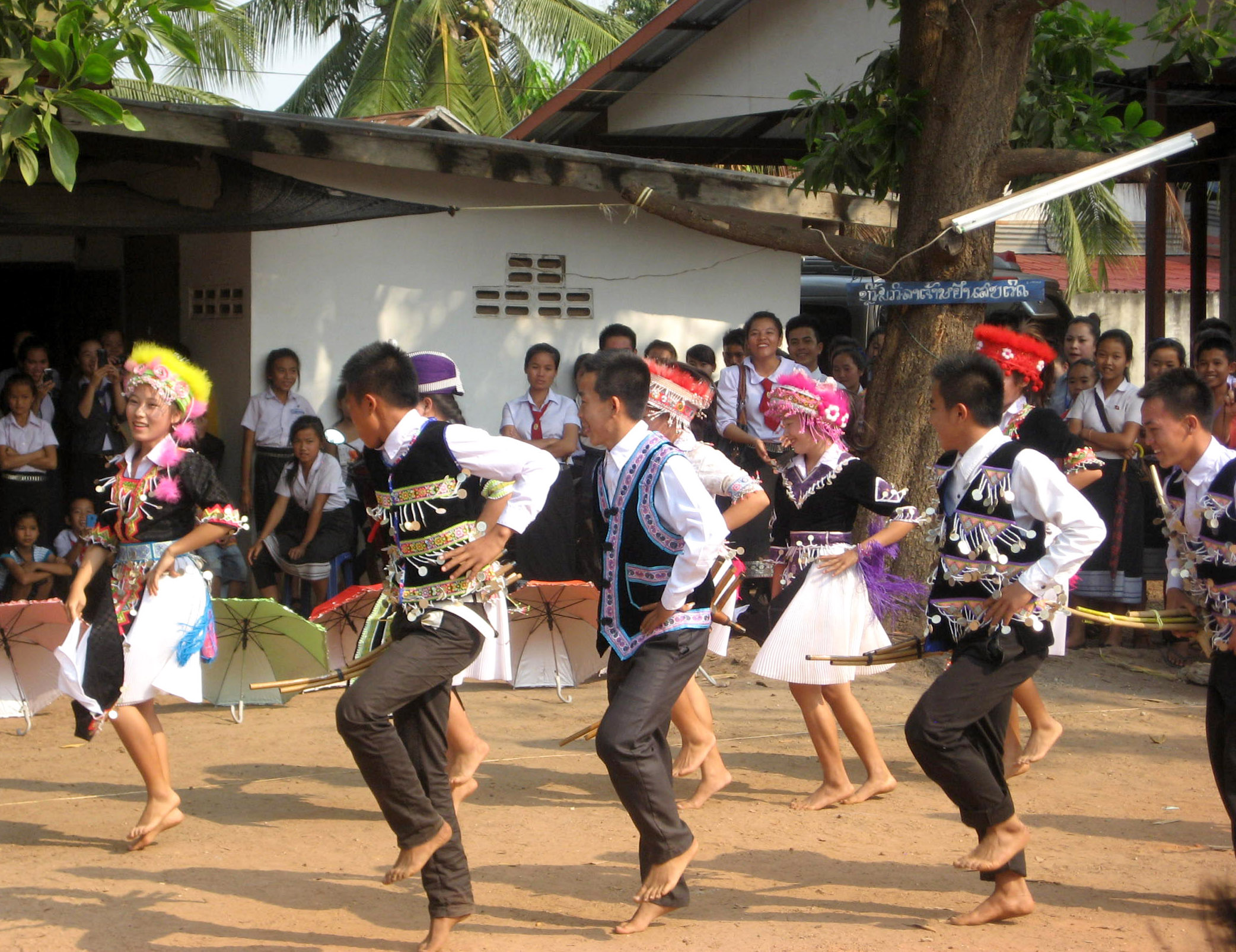|
Hmong Music
Hmong music is an important part of the culture of the Hmong people, an ethnic group from southeast Asia. Because the Hmong language is tonal, there is a close connection between Hmong music and the spoken language. Music is an important part of Hmong life, played for entertainment, for welcoming guests, and at weddings and funerals. Hmong musical instruments includes flutes such as the dra, leaves also called , 2-string violin (xim zaus in Hmong), and the or , a type of mouth organ. History The Hmong people trace their origin to the Yellow River region of China around 2700 B.C. In the 16th century Hmong leaders formed a kingdom in the central Chinese provinces of Hunan, Hubei, and Henan. This kingdom existed for several centuries before being defeated by the Chinese government. Surviving Hmong led to the mountains of Guizhou, Yunnan and Sichuan, where many Hmong still live today. In Hmong folktales and songs, this ancient Hmong kingdom is celebrated as a golden age. Accompa ... [...More Info...] [...Related Items...] OR: [Wikipedia] [Google] [Baidu] |
Hmong People
The Hmong people ( RPA: ''Hmoob'', Nyiakeng Puachue: , Pahawh Hmong: , ) are a sub-ethnic group of the Miao people who originated from Central China. The modern Hmongs presently reside mainly in Southwest China (Guizhou, Yunnan, Sichuan, Chongqing, and Guangxi) and countries in Southeast Asia such as Vietnam, Laos, Thailand, and Myanmar. There is also a very large diasporic community in the United States, comprising more than 300,000 Hmong. The Hmong diaspora also has smaller communities in Australia and South America (specifically Argentina and French Guiana, the latter being an overseas region of France). During the First and Second Indo-China Wars, France and the United States intervened in the Lao Civil War by recruiting thousands of Hmong people to fight against forces from North and South Vietnam, which were stationed in Laos in accordance with their mission to support the communist Pathet Lao insurgents. The CIA operation is known as the Secret War. Etymol ... [...More Info...] [...Related Items...] OR: [Wikipedia] [Google] [Baidu] |
Hmong Language
Hmong / Mong (; RPA: ''Hmoob,'' ; Nyiakeng Puachue: ; Pahawh: , ) is a dialect continuum of the West Hmongic branch of the Hmongic languages spoken by the Hmong people of Sichuan, Yunnan, Guizhou, Guangxi, Hainan, northern Vietnam, Thailand, and Laos. There are some 2.7 million speakers of varieties that are largely mutually intelligible, including over 280,000 Hmong Americans as of 2013. Over half of all Hmong speakers speak the various dialects in China, where the Dananshan (大南山) dialect forms the basis of the standard language. However, Hmong Daw and Mong Leng are widely known only in Laos and the United States; Dananshan is more widely known in the native region of Hmong. Varieties Mong Leng (Moob Leeg) and Hmong Daw (Hmoob Dawb) are part of a dialect cluster known in China as ''Chuanqiandian Miao'', that is, "Sichuan–Guizhou–Yunnan Miao", called the "Chuanqiandian cluster" in English (or "Miao cluster" in other languages) as West Hmongic is also called ''Ch ... [...More Info...] [...Related Items...] OR: [Wikipedia] [Google] [Baidu] |
Tone (linguistics)
Tone is the use of pitch in language to distinguish lexical or grammatical meaning – that is, to distinguish or to inflect words. All verbal languages use pitch to express emotional and other paralinguistic information and to convey emphasis, contrast and other such features in what is called intonation (linguistics), intonation, but not all languages use tones to distinguish words or their inflections, analogously to consonants and vowels. Languages that have this feature are called tonal languages; the distinctive tone patterns of such a language are sometimes called tonemes, by analogy with ''phoneme''. Tonal languages are common in East and Southeast Asia, Africa, the Americas and the Pacific. Tonal languages are different from Pitch-accent language, pitch-accent languages in that tonal languages can have each syllable with an independent tone whilst pitch-accent languages may have one syllable in a word or morpheme that is more prominent than the others. Mechanics Mo ... [...More Info...] [...Related Items...] OR: [Wikipedia] [Google] [Baidu] |
Qeej
Hmong music is an important part of the culture of the Hmong people, an ethnic group from southeast Asia. Because the Hmong language is tonal, there is a close connection between Hmong music and the spoken language. Music is an important part of Hmong life, played for entertainment, for welcoming guests, and at weddings and funerals. Hmong musical instruments includes flutes such as the dra, leaves also called , 2-string violin (xim zaus in Hmong), and the or , a type of mouth organ. History The Hmong people trace their origin to the Yellow River region of China around 2700 B.C. In the 16th century Hmong leaders formed a kingdom in the central Chinese provinces of Hunan, Hubei, and Henan. This kingdom existed for several centuries before being defeated by the Chinese government. Surviving Hmong led to the mountains of Guizhou, Yunnan and Sichuan, where many Hmong still live today. In Hmong folktales and songs, this ancient Hmong kingdom is celebrated as a golden age. Accompa ... [...More Info...] [...Related Items...] OR: [Wikipedia] [Google] [Baidu] |
Yellow River
The Yellow River or Huang He (Chinese: , Standard Beijing Mandarin, Mandarin: ''Huáng hé'' ) is the second-longest river in China, after the Yangtze River, and the List of rivers by length, sixth-longest river system in the world at the estimated length of . Originating in the Bayan Har Mountains in Qinghai province of Western China, it flows through nine provinces, and it empties into the Bohai Sea near the city of Dongying in Shandong province. The Yellow River basin has an east–west extent of about and a north–south extent of about . Its total drainage area is about . The Yellow River's basin was the Yellow River civilization, birthplace of ancient Chinese, and, by extension, Far East, Far Eastern civilization, and it was the most prosperous region in early Chinese history. There are frequent devastating natural disasters in China, floods and course changes produced by the continual elevation of the river bed, sometimes above the level of its surrounding farm fi ... [...More Info...] [...Related Items...] OR: [Wikipedia] [Google] [Baidu] |
Reed Pipe
A reed pipe (also referred to as a ''lingual'' pipe) is an organ pipe that is sounded by a vibrating brass strip known as a ''reed''. Air under pressure (referred to as ''wind'') is directed towards the reed, which vibrates at a specific pitch. This is in contrast to flue pipes, which contain no moving parts and produce sound solely through the vibration of air molecules. Reed pipes are common components of pipe organs. Stop Reed pipes include all stops of the "Reed" class, and some stops from the "Hybrid" class. The reed stops of an organ are collectively called the "reed-work". Construction A reed pipe comprises a metal ''tongue'' (the reed) which rests against a ''shallot'', in which is carved a tunnel. The reed and shallot are held in place by a wooden ''wedge''. This assembly protrudes from the underside of the ''block'' and hangs down into the ''boot''. A ''tuning wire'' is inserted through the boot and is bent to hold the reed against the shallot. The wire is moved u ... [...More Info...] [...Related Items...] OR: [Wikipedia] [Google] [Baidu] |
Gourd Mouth Organ
The gourd mouth organ is a free reed mouth organ played across East and Southeast Asia. It consists of a gourd wind chest with several bamboo or bronze pipes inserted on top of it, the numbers of pipes differing from region to region.Sachs, C. (2012). The history of musical instruments. Courier Corporation. The gourd mouth organ is closely associated with cultural minorities in Asian countries; thus, its styles are diverse, and different counterparts can be seen across different cultures.Uchida, R., & Catlin, A. (2008). Music of upland minorities in Burma, Laos, and Thailand. The Garland Handbook of Southeast Asian Music, 303-316. In southern China, the generic name of the gourd mouth organ is ''Hulu Sheng'' Thrasher, A. R. (2015). Hulu sheng. In New Grove Dictionary of Music and Musicians. Oxford University Press. Retrieved from https://doi.org/10.1093/gmo/9781561592630.article.L2281219 ( 葫芦 笙; pinyin: húlúshēng; literally "gourd sheng"). The accompaniment of the ... [...More Info...] [...Related Items...] OR: [Wikipedia] [Google] [Baidu] |
Free Reed Aerophone
A free reed aerophone is a musical instrument that produces sound as air flows past a vibrating reed in a frame. Air pressure is typically generated by breath or with a bellows. In the Hornbostel–Sachs system, it is number: 412.13 (a member of interruptive free aerophones). Free reed instruments are contrasted with non-free or enclosed reed instruments, where the timbre is fully or partially dependent on the shape of the instrument body, Hornbostel–Sachs number: 42 (flute, reed, and brass). Operation The following illustrations depict the type of reed typical of harmonicas, pitch pipes, accordions, and reed organs as it goes through a cycle of vibration. One side of the reed frame is omitted from the images for clarity; in reality, the frame completely encloses the reed. Airflow over one side of the reed (labeled “AR”) creates a region of low pressure on that side (see the Bernoulli's principle article for details), causing the reed to flex towards the low-pressure si ... [...More Info...] [...Related Items...] OR: [Wikipedia] [Google] [Baidu] |
Hmong Customs And Culture
The Hmong people are an ethnic group currently native to several countries, believed to have come from the Yangtze river basin area in southern China. The Hmong are known in China as the ''Miao'', which encompasses not only Hmong, but also other related groups such as Hmu, Qo Xiong and A-Hmao. There is debate about usage of this term, especially amongst Hmong living in the West, as it is believed by some to be derogatory, although Hmong living in China still call themselves by this name. Throughout recorded history, the Hmong have remained identifiable as Hmong because they have maintained the Hmong language, customs, and ways of life while adopting the ways of the country in which they live. In the 1960s and 1970s, many Hmong were secretly recruited by the American CIA to fight against communism during the Vietnam War. After American armed forces pulled out of Vietnam, a communist regime took over in Laos and ordered the prosecution and re-education of all those who had fought ... [...More Info...] [...Related Items...] OR: [Wikipedia] [Google] [Baidu] |
Hmong Culture
The Hmong people are an ethnic group currently native to several countries, believed to have come from the Yangtze river basin area in southern China. The Hmong are known in China as the ''Miao'', which encompasses not only Hmong, but also other related groups such as Hmu, Qo Xiong and A-Hmao. There is debate about usage of this term, especially amongst Hmong living in the West, as it is believed by some to be derogatory, although Hmong living in China still call themselves by this name. Throughout recorded history, the Hmong have remained identifiable as Hmong because they have maintained the Hmong language, customs, and ways of life while adopting the ways of the country in which they live. In the 1960s and 1970s, many Hmong were secretly recruited by the American CIA to fight against communism during the Vietnam War. After American armed forces pulled out of Vietnam, a communist regime took over in Laos and ordered the prosecution and re-education of all those who had fought ... [...More Info...] [...Related Items...] OR: [Wikipedia] [Google] [Baidu] |








